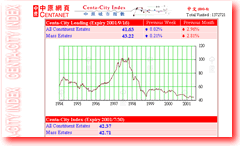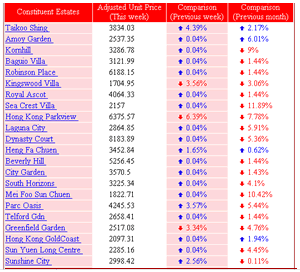Index to gauge local property market
Launched in 1999, the Centa-City Index is a collaborative venture between City University's Management Sciences Department and Centaline Property Agency Limited, a leader in its field in Hong Kong. The Index in fact comprises two indicators: the monthly Centa-City Index (to be released on the 18th of each month), which draws on Land Registry data on monthly property transactions, and the weekly Centa-City Leading Index (to be released every Friday), which relies on data from weekly transactions handled by Centaline.
Both indices rely on a number of constituent estates (at present: 38) and had a base of 100 on
1 July 1997. On 25 September 2001, for example, the Centa-City Index and the Centa-City Leading Index stood at 42.43 and 41.63 respectively. The former, released on 30 July, draws on transaction data in the month up to 30 September, while the latter, reflects data in the week before 16 September.
"It's the reputation of the second index we are trying to build up," said Professor Y V Hui. The weekly index is based on the current preliminary contract prices of Centaline transactions,
which account for more than a 20% share of property-agent market. As such, it is intended not only to monitor up-to-date property prices variations but also serve as an indication of the market trend. "Generally speaking, the two indices have in the past followed similar paths of movement, with the Leading Index sort of pointing the way for the other by a few weeks in advance," said Dr Y C Chan (see chart), "because land registration usually takes some time, and any index based on the Land Registry's data inevitably could not provide the most up-to-date information." In this context, the Leading Index fills a timely and important need among quantity surveyors, property agents, real estate valuators, stock analysts and economic researchers and lawyers who have a vested interest in the property market.In the joint research project, Centaline provides the seed money for equipment and staffing expenses as well as the necessary data, while CityU's team comes up with the sophisticated computation model and programming skills to whip the data into shape for presentation on the World-Wide Web. "Centaline recognized the value and potential of this project from the very beginning," said Dr Y C Chan, "and they have been enthusiastic and generous with their support."
Based on Centaline's transaction data in the previous week, an adjusted unit price of an estate for the current week is computed. This looks like a relatively simple step. The contribution by CityU's team, however, lies in its expertise in providing a formula to determine the market value of each property. A regression model will take into account the relative effect on the property's value of such attributes as size, years of occupancy, location, direction, view, floor level, transportation, external decor, facilities and management services, etc. Since 1994, Centaline has, with the help of a contingent of property agents in the field, started to meticulously gather and update such data on all properties in the constituent estates. In some extreme cases, whether serious crimes and fire have occurred in the premises have also been factored in.
The number of constituent estates will vary, said Dr Alan Wan. "Like the Hang Seng Index, some constituents will be added while others will be dropped during a review process." Consideration for inclusion as a constituent estate, he says, has to satisfy the following criteria: it has high transaction volume and value; a minimum of 12 months in the market after occupancy; and, it is representative of its region. At present, there are 38 constituent estates, including such popular locations like Kornhill Gardens, Royal Ascot, Taikoo Shing, Southern Horizon and Telford Gardens. But, as more and more new property estates have come on stream in the past year, the number is likely to increase.
"For a long time, the property market has been a mainstream of Hong Kong's economy and there was no indicator to gauge its health," said Professor Hui. "Now Centa-City Index will fill this void." A number of banks and economic research institutes have shown interest not only in the data but also the model behind the computation. Some newspapers have featured the indices regularly in their pages. The team's hope, given strenuous tests over time, is that the Indexes will become the standard reference tool for property traders and investors, much as the Hang Seng Index is for the local stock market. "Greater acceptance and creditability is the key," said
Dr Chan. By then, maybe, the time will be ripe to export their expertise to other Asian cities.
Centa-City Index Research Team Members:
Professor L K Chan
Dr Y C Chan
Professor Y V Hui
Dr H P Lo
Dr S K Tse,
Dr Alan Wan
Dr Kelvin Yau
Ms S L Cheung
Ms Sunee Tang



